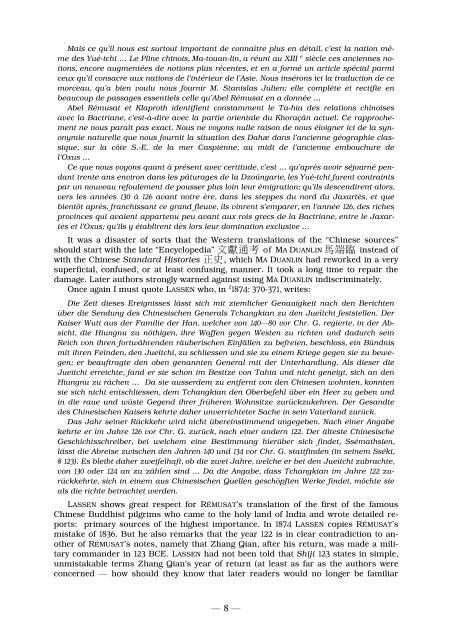張騫 Zhang Qian. The Secret Envoy of Han Emperor Wu in Search of the Arsi (Yuezhi) and the Fall of the Græco-Bactrian Kingdom. (Annotated Compilation of Eastern and Western Sources)
The study undertakes: — to clarify in what year Zhang Qian reached the Oxus river; to establish that the Daxia 大夏 in Shiji 123 represent the Tachar/Tochar of Tochar-i-stan; to explain how we are to understand the "List of Four" in Strabon 11.8.2.
The study undertakes: —
to clarify in what year Zhang Qian reached the Oxus river;
to establish that the Daxia 大夏 in Shiji 123 represent the Tachar/Tochar of Tochar-i-stan;
to explain how we are to understand the "List of Four" in Strabon 11.8.2.
You also want an ePaper? Increase the reach of your titles
YUMPU automatically turns print PDFs into web optimized ePapers that Google loves.
Mais ce qu’il nous est surtout important de connaître plus en détail, c’est la nation même<br />
des Yué-tchi … Le Pl<strong>in</strong>e ch<strong>in</strong>ois, Ma-touan-l<strong>in</strong>, a réuni au XIII e siècle ces anciennes notions,<br />
encore augmentées de notions plus récentes, et en a formé un article spécial parmi<br />
ceux qu’il consacre aux nations de l’<strong>in</strong>térieur de l’Asie. Nous <strong>in</strong>sérons ici la traduction de ce<br />
morceau, qu’a bien voulu nous fournir M. Stanislas Julien; elle complète et rectifie en<br />
beaucoup de passages essentiels celle qu’Abel Rémusat en a donnée …<br />
Abel Rémusat et Klaproth identifient constamment le Ta-hia des relations ch<strong>in</strong>oises<br />
avec la <strong>Bactrian</strong>e, c’est-à-dire avec la partie orientale du Khoraçân actuel. Ce rapprochement<br />
ne nous paraît pas exact. Nous ne voyons nulle raison de nous éloigner ici de la synonymie<br />
naturelle que nous fournit la situation des Dahæ dans l’ancienne géographie classique,<br />
sur la côte S.-E. de la mer Caspienne, au midi de l’ancienne embouchure de<br />
l’Oxus …<br />
Ce que nous voyons quant à présent avec certitude, c’est … qu’après avoir séjourné pendant<br />
trente ans environ dans les pâturages de la Dzoûngarie, les Yué-tchi furent contra<strong>in</strong>ts<br />
par un nouveau refoulement de pousser plus lo<strong>in</strong> leur émigration; qu’ils descendirent alors,<br />
vers les années 130 à 126 avant notre ère, dans les steppes du nord du Jaxartès, et que<br />
bientôt après, franchissant ce gr<strong>and</strong> fleuve, ils v<strong>in</strong>rent s’emparer, en l’année 126, des riches<br />
prov<strong>in</strong>ces qui avaient appartenu peu avant aux rois grecs de la <strong>Bactrian</strong>e, entre le Jaxartès<br />
et l’Oxus; qu’ils y établirent dès lors leur dom<strong>in</strong>ation exclusive …<br />
It was a disaster <strong>of</strong> sorts that <strong>the</strong> <strong>Western</strong> translations <strong>of</strong> <strong>the</strong> “Ch<strong>in</strong>ese sources”<br />
should start with <strong>the</strong> late “Encyclopedia” 文 獻 通 考 <strong>of</strong> MA D UANLIN 馬 端 臨 <strong>in</strong>stead <strong>of</strong><br />
w ith <strong>the</strong> Ch<strong>in</strong>ese St<strong>and</strong>ard Histories 正 史 , which MA DUANLIN had reworked <strong>in</strong> a very<br />
superficial, confused, or at least confus<strong>in</strong>g, manner. It took a long time to repair <strong>the</strong><br />
damage. Later authors strongly warned aga<strong>in</strong>st us<strong>in</strong>g MA DUANLIN <strong>in</strong>discrim<strong>in</strong>ately.<br />
Once aga<strong>in</strong> I must quote LASSEN who, <strong>in</strong> 2 1874: 370-371, writes:<br />
Die Zeit dieses Ereignisses lässt sich mit ziemlicher Genauigkeit nach den Berichten<br />
über die Sendung des Ch<strong>in</strong>esischen Generals Tchangkian zu den Jueïtchi feststellen. Der<br />
Kaiser <strong>Wu</strong>ti aus der Familie der <strong>Han</strong>, welcher von 140—80 vor Chr. G. regierte, <strong>in</strong> der Absicht,<br />
die Hiungnu zu nöthigen, ihre Waffen gegen Westen zu richten und dadurch se<strong>in</strong><br />
Reich von ihren fortwährenden räuberischen E<strong>in</strong>fällen zu befreien, beschloss, e<strong>in</strong> Bündnis<br />
mit ihren Fe<strong>in</strong>den, den Jueïtchi, zu schliessen und sie zu e<strong>in</strong>em Kriege gegen sie zu bewegen;<br />
er beauftragte den oben genannten General mit der Unterh<strong>and</strong>lung. Als dieser die<br />
Jueïtchi erreichte, f<strong>and</strong> er sie schon im Besitze von Tahia und nicht geneigt, sich an den<br />
Hiungnu zu rächen … Da sie ausserdem zu entfernt von den Ch<strong>in</strong>esen wohnten, konnten<br />
sie sich nicht entschliessen, dem Tchangkian den Oberbefehl über e<strong>in</strong> Heer zu geben und<br />
<strong>in</strong> die raue und wüste Gegend ihrer früheren Wohnsitze zurückzukehren. Der Ges<strong>and</strong>te<br />
des Ch<strong>in</strong>esischen Kaisers kehrte daher unverrichteter Sache <strong>in</strong> se<strong>in</strong> Vaterl<strong>and</strong> zurück.<br />
Das Jahr se<strong>in</strong>er Rückkehr wird nicht übere<strong>in</strong>stimmend angegeben. Nach e<strong>in</strong>er Angabe<br />
kehrte er im Jahre 126 vor Chr. G. zurück, nach e<strong>in</strong>er <strong>and</strong>ern 122. Der älteste Ch<strong>in</strong>esische<br />
Geschichtsschreiber, bei welchem e<strong>in</strong>e Bestimmung hierüber sich f<strong>in</strong>det, Ssémathsien,<br />
lässt die Abreise zwischen den Jahren 140 und 134 vor Chr. G. stattf<strong>in</strong>den (<strong>in</strong> se<strong>in</strong>em Sséki,<br />
§ 123). Es bleibt daher zweifelhaft, ob die zwei Jahre, welche er bei den Jueïtchi zubrachte,<br />
von 130 oder 124 an zu zählen s<strong>in</strong>d ... Da die Angabe, dass Tchangkian im Jahre 122 zurückkehrte,<br />
sich <strong>in</strong> e<strong>in</strong>em aus Ch<strong>in</strong>esischen Quellen geschöpften Werke f<strong>in</strong>det, möchte sie<br />
als die richte betrachtet werden.<br />
LASSEN shows great respect for RÉMUSAT’s translation <strong>of</strong> <strong>the</strong> first <strong>of</strong> <strong>the</strong> famous<br />
Ch<strong>in</strong>ese Buddhist pilgrims who came to <strong>the</strong> holy l<strong>and</strong> <strong>of</strong> India <strong>and</strong> wrote detailed repor<br />
ts: primary sources <strong>of</strong> <strong>the</strong> highest importance. In 1874 LASSEN copies RÉMUSAT’s<br />
mistake <strong>of</strong> 1836. But he also remarks that <strong>the</strong> year 122 is <strong>in</strong> clear contradiction to an-<br />
<strong>of</strong> RÉMUSAT’s notes, namely that <strong>Zhang</strong> <strong>Qian</strong>, after his return, was made a mili-<br />
o<strong>the</strong>r<br />
t ary comm<strong>and</strong>er <strong>in</strong> 123 BCE. LASSEN had not been told that Shiji 123 states <strong>in</strong> simple,<br />
u nmistakable terms <strong>Zhang</strong> <strong>Qian</strong>’s year <strong>of</strong> return (at least as far as <strong>the</strong> authors were<br />
concerned — how should <strong>the</strong>y know that later readers would no longer be familiar<br />
— 8 —


